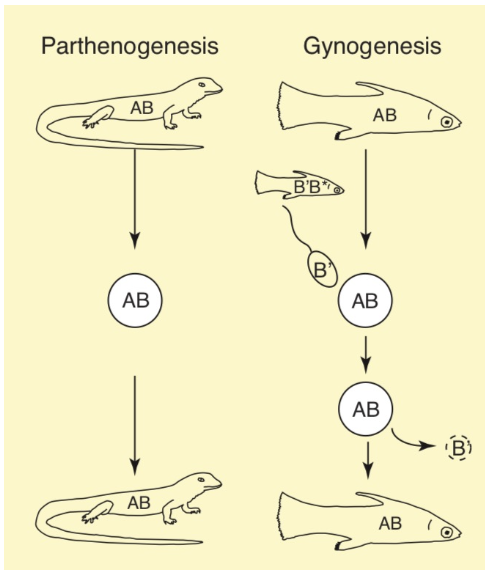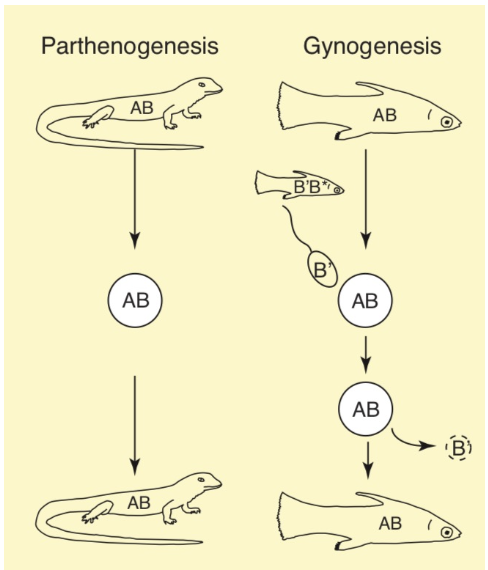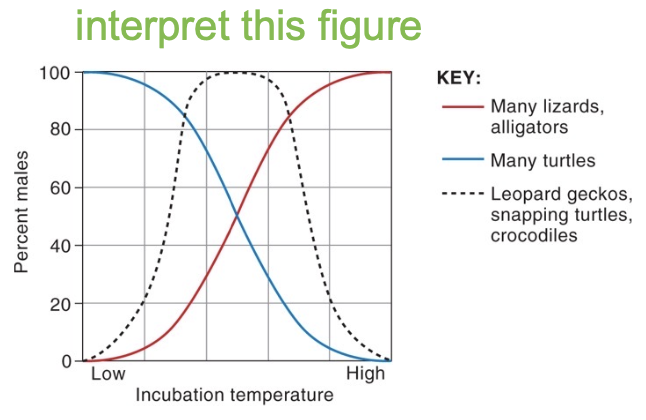UCM GenBioII Final - Animal Reproduction
1/34
There's no tags or description
Looks like no tags are added yet.
Name | Mastery | Learn | Test | Matching | Spaced |
|---|
No study sessions yet.
35 Terms
asexual reproduction
one parent
no reproductive organs or cells
offspring genetically identical clone of parent
sexual reproduction
two parents
gametes produced during meiosis
zygote formed
offspring are genetically unique mixture of parents
budding
asexual reproduction
new individuals arise as an outgrowth from parent
fragmentation
fragments of multicellular organisms can become complete organisms
bisexual reproduction
union of two genetically different gametes
each parent parent produces one kind of germ cell during meiosis (sperm and ova)
monoecious organisms
can self fertilize = sexual reproduction
parthenogenesis
development of offspring from unfertilized eggs
typically clones
can be obligate or cyclical

gynogenesis
sperm dependents parthenogenesis
females are spam parasites that mate with heterospecific males

red queen hypothesis
sex should be more common in populations with heavy parasite loads bc genetic variation makes it harder for parasites to adapt to hosts
spermatogenesis
results in the production of four haploid spermatids
oogenesis
meiosis I produces two haploid cells, meiosis II stops at the metaphase and does not continue unless the egg is fertilized
oviparity
egg-laying
energetically inexpensive
variable offspring survival
viviparity
live-bearing
energetically expensive
allows for behavioral thermoregulation
high offspring survival
anamniotic
Eggs of aquatic species relying on external fertilization are often jelly-like and can absorb some nutrients from the aqueous environment
amniotic
eggs evolved in terrestrial environments, shelled
amnion
encloses the embryo, cushion
allantois
storage of metabolic waste
chorion
highly vascularized, serves in gas exchange
yolk sac
storage of nutrients
shell
porous, prevents water loss
monotremes
mammals that lay eggs
milk patches
metatherians
marsupials
short gestation, long parental care
pouches
eutherians
placental mammals
long gestation, short parental care
sex
a distinction based on the type of gametes produced by an individual
gender
a social construct used to describe traits associated with the binary sexes
XX/YY
insects, fish, mammals
Y-centered = determines maleness
X-centered = determines femaleness
ZZ/ZW
some insects. fish, mammals
males are homogametic
needs two copies of DMRT1 gene for male development
haplodiploidy
hymenopteran insects
environmental conditions can influence development of sex specific traits
ex) location, temp, social

protandry
male → female
protogyny
female → male
primary sexual characteristics
gamete producing and reproductive structures
secondary sexual characteristics
develop later in life, include things such as bright coloration, horns, behavior
more offspring, less energy
smaller
greater fecundity
bigger